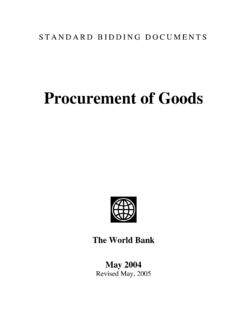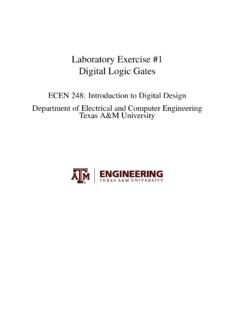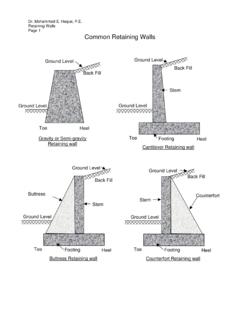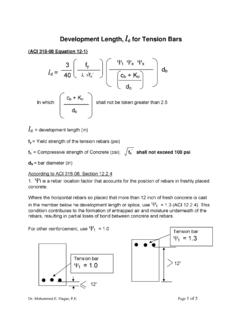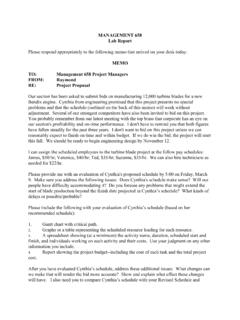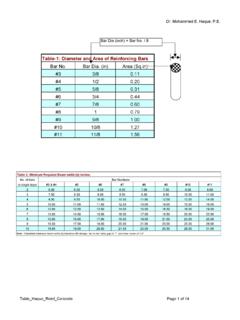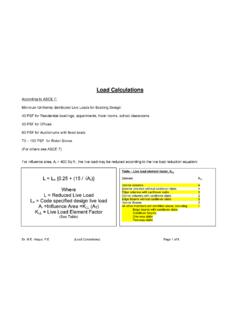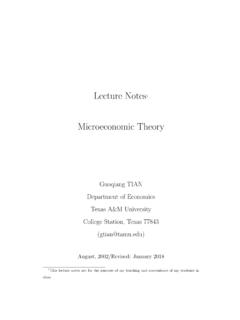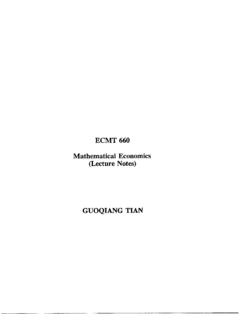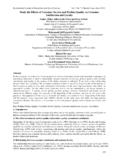Transcription of The Value Chain From Competitive Advantage , by Michael …
1 The Value Chain From Competitive Advantage , by Michael Porter Every firm is a collection of activities that are performed to design, produce, market, deliver, and support its product. All these activities can be represented using a Value Chain . A firm s Value Chain and the way it performs individual activities are a reflection of its history, its strategy, its approach to implementing its strategy, and the underlying economics of the activities themselves. The relevant level for constructing a Value Chain is a firm s activities in a particular industry (the business unit). An industry- or sector-wide Value Chain is too broad, because it may obscure important sources of Competitive Advantage . Though firms in the same industry may have similar chains the Value chains of competitors often differ. Low cost and full-service airlines both compete in the airline industry, for example, but they have very different Value chains embodying significant differences in boarding gate operations, crew policies, and aircraft operations.
2 Differences among competitor Value chains are a key source of Competitive Advantage . A firm s Value Chain in an industry may vary somewhat for different items in its product line, or different buyers, geographic areas, or distribution channels. The Value chains for such subsets of a firm are closely related, however, and can only be understood in the context of the business unit Chain . In Competitive terms, Value is the amount buyers are willing to pay for what a firm provides them. Value is measured by total revenue, a reflection of the price a firm s product commands and the units it can sell. A firm is profitable if the Value it commands exceeds the costs involved in creating the product. Creating Value for buyers that exceeds the cost of doing so is the goal of any generic strategy. Value , instead of cost, must be used in analyzing Competitive position since firms often deliberately raise their cost to command a premium price via differentiation.
3 The Value Chain displays total Value , and consists of Value activities and margin. Value activities are the physically and technologically distinct activities a firm performs. These are the building blocks by which a firm creates a product valuable to its buyers. Margin is the difference between total Value and the collective cost of performing the Value activities. Margin can be measured in a variety of ways. Supplier and channel Value chains also include a margin that is important to isolate in understanding the sources of a firm s cost position, since supplier and channel margin are part of the total cost borne by the buyer. Every Value activity employs purchased inputs, human resources (labor and management), and some form of technology to perform its function. Each Value activity also uses and creates information, such as buyer data (order entry), performance parameters (testing), and product failure statistics.
4 Value activities may also create financial assets such as inventory and accounts receivable, or liabilities such as accounts payable. Value activities can be divided into two broad types, primary activities and support activities. Primary activities are the activities involved in the physical creation of the product and its sale and transfer to the buyer as well as after-sale assistance. In any firm, primary activities can be divided into the five generic categories. (Handout) Support activities support the primary activities and each other by providing purchased inputs, technology, human resources, and various firm-wide functions. The dotted lines reflect the fact that procurement, technology development, and human resource management can be associated with specific primary activities as well as support the entire Chain . Firm infrastructure is not associated with particular primary activities but supports the entire Chain .
5 Value activities are therefore the discrete building blocks of Competitive Advantage . How each activity is performed combined with its economics will determine whether a firm is high or low cost compared to competitors. How each Value activity is performed will also determine its contribution to buyer needs and hence differentiation. Comparing the Value chains of competitors exposes differences that determine Competitive Advantage . An analysis of the Value Chain rather than Value added is the appropriate way to examine Competitive Advantage . Value added (selling price less the cost of purchased raw materials) has sometimes been used as the focal point for cost analysis because it was viewed as the area in which a firm can control costs. Value added is not a sound basis for cost analysis, however, because it incorrectly distinguishes raw materials from the many other purchased inputs used in a firm s activities.
6 Also, the cost behavior of activities cannot be understood without simultaneously examining the costs of the inputs used to perform them. Moreover, Value added fails to highlight the linkages between a firm and its suppliers that can reduce cost or enhance differentiation. Identifying Value Activities Identifying Value activities requires the isolation of activities that are technologically and strategically distinct. Value activities and accounting classifications are rarely the same. Accounting classifications ( , burden, overhead, direct labor) group together activities with disparate technologies, and separate costs that are all part of the same activity. PRIMARY ACTIVITIES There are five generic categories of primary activities involved in competing in any industry. Each category is divisible into a number of distinct activities that depend on the particular industry and firm strategy: Inbound Logistics.
7 Activities associated with receiving, storing, and disseminating inputs to the product, such as material handling, warehousing, inventory control, vehicle scheduling, and returns to suppliers. Operations. Activities associated with transforming inputs into the final product form, such as machining, packaging, assembly, equipment maintenance, testing, printing, and facility operations. Outbound Logistics. Activities associated with collecting, storing, and physically distributing the product to buyers, such as finished goods warehousing, material handling, delivery vehicle operation, order processing, and scheduling. Marketing and Sales. Activities associated with providing a means by which buyers can purchase the product and inducing them to do so, such as advertising, promotion, sales force, quoting, channel selection, channel relations, and pricing.
8 Service. Activities associated with providing service to enhance or maintain the Value of the product, such as installation, repair, training, parts supply, and product adjustment. Each of the categories may be vital to Competitive Advantage depending on the industry. For a distributor, inbound and outbound logistics are the most critical. For a service firm providing the service on its premises such as a restaurant or retailer, outbound logistics may be largely nonexistent and operations the vital category. For a bank engaged in corporate lending, marketing and sales are a key to Competitive Advantage through the effectiveness of the calling officers and the way in which loans are packaged and priced. For a high-speed copier manufacturer, service represents a key source of Competitive Advantage . In any firm, however, all the categories of primary activities will be present to some degree and play some role in Competitive Advantage .
9 Support Activities Support Value activities involved in competing in any industry can be divided into four generic categories. As with primary activities, each category of support activities is divisible into a number of distinct Value activities that are specific to a given industry. In technology development, for example, discrete activities might include component design, feature design, field-testing, process engineering, and technology selection. Similarly, procurement can be divided into activities such as qualifying new suppliers, procurement of different groups of purchased inputs, and ongoing monitoring of supplier performance. Procurement. Procurement refers to the function of purchasing inputs used in the firm s Value Chain , not to the purchased inputs themselves. Purchased inputs include raw materials, supplies, and other consumable items as well as assets such as machinery, laboratory equipment, office equipment, and buildings.
10 Though purchased inputs are commonly associated with primary activities, purchased inputs are present in every Value activity including support activities. For example, laboratory supplies and independent testing services are common purchased inputs in technology development, while an accounting firm is a common purchased input in firm infrastructure. Like all Value activities, procurement employs a technology, such as procedures for dealing with vendors, qualification rules, and information systems. Procurement tends to be spread throughout a firm. Some items such as raw materials are purchased by the traditional purchasing department, while other items are purchased by plant managers ( , machines), office managers ( , temporary help), salespersons ( , meals and lodging), and even the chief executive officer ( , strategic consulting). I use the term procurement rather than purchasing because the usual connotation of purchasing is too narrow among managers.
